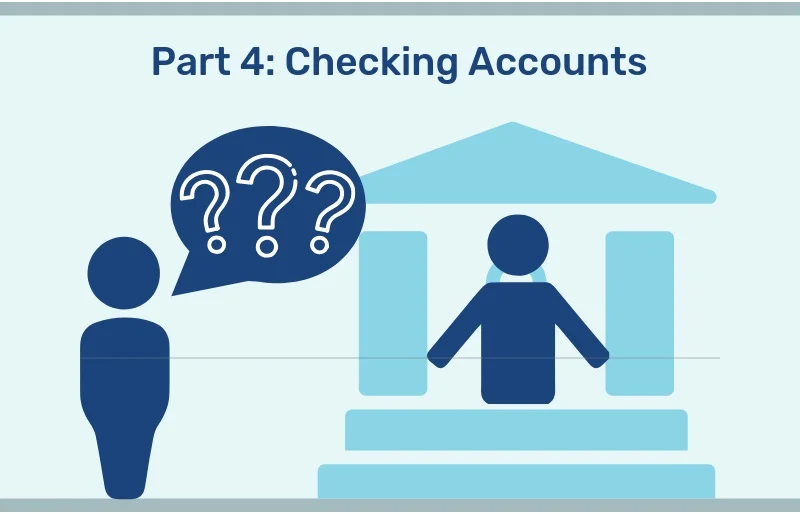Being a Smart Banking Consumer: More Common Account Activities
/Banks are a place for us to handle our checking, savings, and possibly a loan. Beyond that, for many of us banking is a black hole. Why banks do what they do and how they do it is little understood outside of the banking community.
The more information you have, the better consumer you can be.
Being a Smart Banking Consumer
(Part 7): More Common Account Activities
In the last post, we began reviewing common checking account activities. Here, we will continue to discuss the most common types of transactions that you or the bank initiates, and the implications for you as the banking client. Again, we will deal only with checking accounts, as transactions completed using savings accounts and CDs were detailed in the article on savings accounts.
Normal Funds Availability
Check deposits are “made available” on the first business day after the day the bank receives your deposit. “Made available” means basically that— the amount of money deposited will be available to you for use. You can use these funds to pay checks presented for payment, as well as for cash withdrawals.
You must make the deposit before a certain time each day for it to be available the next business day. That time is usually between 2 and 3 PM. If the deposit is made after that time, the next day is considered the day of deposit.
For example, if you deposit a check on Monday morning, the funds will become available on Tuesday. If the check is deposited after the cutoff time on Monday, then Tuesday is considered the day of deposit, and the funds will be made available on Wednesday. If a holiday falls on one of those days, the availability of the funds may be delayed until the next business day.
Federal regulations do, however, require the bank to make the first $400 of the deposit to be made available on the day of the deposit. If the amount of the check is larger than $400, the first $400 will be available to you that day. The rest will be made available on the following business day.
Unusual Funds Availability
According to federal regulations, check deposits may not be made available the next business day under the following circumstances:
The bank believes a check will not be paid;
You deposit more than $5,000 in one day;
You redeposit a check that has been returned unpaid;
You have overdrawn your account repeatedly in the last six months; or
The bank has an emergency such as computer failure or another emergency that requires the bank to shut down.
In these circumstances, the bank may not make the funds available for up to 7 to 9 business days. The bank is required to notify you in writing the day of the deposit of the hold. They must also notify you of the time frame in which it will hold the funds before they become available to you.
Holds on Your Account
In part 2 of this series, we touched on the rights and responsibilities of the bank, which include monitoring suspicious activity. For example, if the bank has reason to believe a check has been altered, forged, unauthorized, has a missing signature or should not have been paid for any reason, the bank will place a hold on a deposited check. The hold will continue until the bank can be assured that the situation has been resolved. Once resolved, the amount of money involved in the hold is either credited or deducted from your account.
Non-U.S. Items
Banks receive checks from many different financial institutions each day, and it is not practical to deal with each bank separately. Normally, the bank sends all the checks it receives in a day to the Federal Reserve for processing. As a result, the Federal Reserve acts as a clearinghouse— the FED receives all the daily checks from each bank in the U.S. and sends those checks in large batches to the appropriate banks for payment.
The collection process for non-U.S. items is different from its normal process. A non-U.S. item can be one of two things:
- a check payable in a currency other than U.S. dollars, or
- a check drawn on a financial institution that is not organized under United States law.
A U.S. bank is not required to accept a non-U.S. item. If it does accept the item, the bank will send the item out for “collection.” Collection is a bank-to-bank process. During the collection process for non-U.S. items, your bank will send the check directly to the other bank for payment.
Checks Returned Unpaid
When a bank is notified that a check you deposited is being returned unpaid, the amount indicated on the check is deducted from your account balance. The bank will deduct this amount even if the balance in the account is not enough to cover that amount. In addition, the bank will charge you a fee. Even further, if the account is an interest-bearing account, the bank will also deduct any interest that was accrued on the item.
To learn more about the process behind checks returned unpaid, you can refer to this infographic for more detail:
Stay tuned for Part 7 as we continue to cover basic banking.
© Whatismyhealth


























A checklist of common documents related to deductions and credits that you will need when preparing to file your taxes for last year.